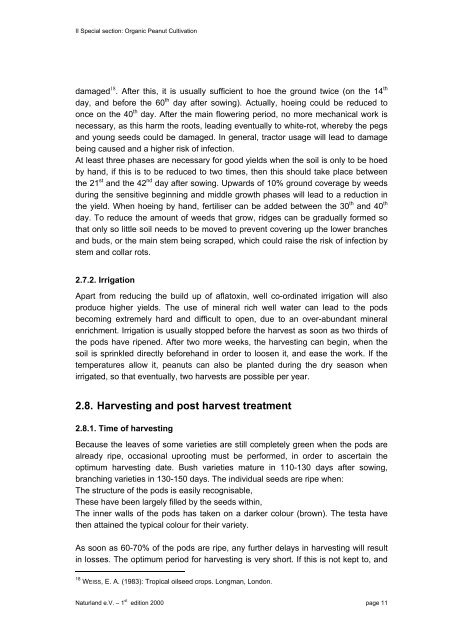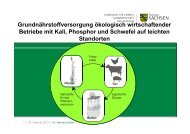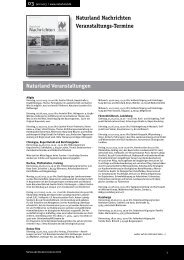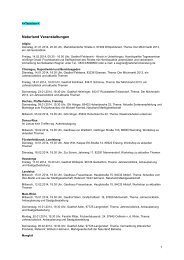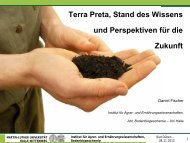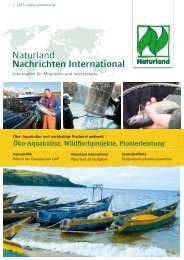Organic Farming in the Tropics and Subtropics: Peanuts - Naturland
Organic Farming in the Tropics and Subtropics: Peanuts - Naturland
Organic Farming in the Tropics and Subtropics: Peanuts - Naturland
You also want an ePaper? Increase the reach of your titles
YUMPU automatically turns print PDFs into web optimized ePapers that Google loves.
II Special section: <strong>Organic</strong> Peanut Cultivation<br />
damaged 18 . After this, it is usually sufficient to hoe <strong>the</strong> ground twice (on <strong>the</strong> 14 th<br />
day, <strong>and</strong> before <strong>the</strong> 60 th day after sow<strong>in</strong>g). Actually, hoe<strong>in</strong>g could be reduced to<br />
once on <strong>the</strong> 40 th day. After <strong>the</strong> ma<strong>in</strong> flower<strong>in</strong>g period, no more mechanical work is<br />
necessary, as this harm <strong>the</strong> roots, lead<strong>in</strong>g eventually to white-rot, whereby <strong>the</strong> pegs<br />
<strong>and</strong> young seeds could be damaged. In general, tractor usage will lead to damage<br />
be<strong>in</strong>g caused <strong>and</strong> a higher risk of <strong>in</strong>fection.<br />
At least three phases are necessary for good yields when <strong>the</strong> soil is only to be hoed<br />
by h<strong>and</strong>, if this is to be reduced to two times, <strong>the</strong>n this should take place between<br />
<strong>the</strong> 21 st <strong>and</strong> <strong>the</strong> 42 nd day after sow<strong>in</strong>g. Upwards of 10% ground coverage by weeds<br />
dur<strong>in</strong>g <strong>the</strong> sensitive beg<strong>in</strong>n<strong>in</strong>g <strong>and</strong> middle growth phases will lead to a reduction <strong>in</strong><br />
<strong>the</strong> yield. When hoe<strong>in</strong>g by h<strong>and</strong>, fertiliser can be added between <strong>the</strong> 30 th <strong>and</strong> 40 th<br />
day. To reduce <strong>the</strong> amount of weeds that grow, ridges can be gradually formed so<br />
that only so little soil needs to be moved to prevent cover<strong>in</strong>g up <strong>the</strong> lower branches<br />
<strong>and</strong> buds, or <strong>the</strong> ma<strong>in</strong> stem be<strong>in</strong>g scraped, which could raise <strong>the</strong> risk of <strong>in</strong>fection by<br />
stem <strong>and</strong> collar rots.<br />
2.7.2. Irrigation<br />
Apart from reduc<strong>in</strong>g <strong>the</strong> build up of aflatox<strong>in</strong>, well co-ord<strong>in</strong>ated irrigation will also<br />
produce higher yields. The use of m<strong>in</strong>eral rich well water can lead to <strong>the</strong> pods<br />
becom<strong>in</strong>g extremely hard <strong>and</strong> difficult to open, due to an over-abundant m<strong>in</strong>eral<br />
enrichment. Irrigation is usually stopped before <strong>the</strong> harvest as soon as two thirds of<br />
<strong>the</strong> pods have ripened. After two more weeks, <strong>the</strong> harvest<strong>in</strong>g can beg<strong>in</strong>, when <strong>the</strong><br />
soil is spr<strong>in</strong>kled directly beforeh<strong>and</strong> <strong>in</strong> order to loosen it, <strong>and</strong> ease <strong>the</strong> work. If <strong>the</strong><br />
temperatures allow it, peanuts can also be planted dur<strong>in</strong>g <strong>the</strong> dry season when<br />
irrigated, so that eventually, two harvests are possible per year.<br />
2.8. Harvest<strong>in</strong>g <strong>and</strong> post harvest treatment<br />
2.8.1. Time of harvest<strong>in</strong>g<br />
Because <strong>the</strong> leaves of some varieties are still completely green when <strong>the</strong> pods are<br />
already ripe, occasional uproot<strong>in</strong>g must be performed, <strong>in</strong> order to ascerta<strong>in</strong> <strong>the</strong><br />
optimum harvest<strong>in</strong>g date. Bush varieties mature <strong>in</strong> 110-130 days after sow<strong>in</strong>g,<br />
branch<strong>in</strong>g varieties <strong>in</strong> 130-150 days. The <strong>in</strong>dividual seeds are ripe when:<br />
The structure of <strong>the</strong> pods is easily recognisable,<br />
These have been largely filled by <strong>the</strong> seeds with<strong>in</strong>,<br />
The <strong>in</strong>ner walls of <strong>the</strong> pods has taken on a darker colour (brown). The testa have<br />
<strong>the</strong>n atta<strong>in</strong>ed <strong>the</strong> typical colour for <strong>the</strong>ir variety.<br />
As soon as 60-70% of <strong>the</strong> pods are ripe, any fur<strong>the</strong>r delays <strong>in</strong> harvest<strong>in</strong>g will result<br />
<strong>in</strong> losses. The optimum period for harvest<strong>in</strong>g is very short. If this is not kept to, <strong>and</strong><br />
18 WEISS, E. A. (1983): Tropical oilseed crops. Longman, London.<br />
Naturl<strong>and</strong> e.V. – 1 st edition 2000 page 11


